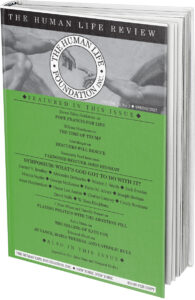Suicide Acceptance, Abortion Acceptance
Abortion remains at the center of the pro-life movement, which began as a reaction against efforts to legalize the practice in one country after another across the Western world in the middle of the last century. Those efforts largely succeeded, in the United States and elsewhere, leaving the pro-life movement since then to operate on different tracks. It drafts and promotes legislation that would reduce the exposure of unborn children to harm now, in the short term, while lawyers and advocates debate strategies for their longer-term project: First, persuade the public that the abortion of unborn children should be unthinkable. Then, when that consensus is established, induce judges to rule that it should be illegal. That’s the mind of the pro-life movement. Some prolifers would say that its heart and soul are the non-profit pregnancy centers that serve women who feel pressure, often economic, to abort but down deep want to carry their pregnancies to term.
Early on, the National Right to Life Committee here in America raised the umbrella of the movement just high enough to take in the related issue of euthanasia and then its cousin, physician-assisted suicide. A dagger aimed at either end of the human lifespan, the concept of abortion, euthanasia, and assisted suicide as members of a family of medical practices whose shared objective is to produce or hasten death makes sense up to a point. They are medical practices, after all—in violation of the Hippocratic Oath, their critics contend, but nonetheless carried out by, or under the direction of, physicians in clinics, hospitals, and nursing homes.
The psychiatrist and historian Robert Jay Lifton writes of the gradual “medicalization of killing” in Germany in the 1930s and 1940s. Aktion T4, it was called, the government-sponsored program of mass “mercy killing”: Doctors began to take the lives of patients, often through starvation, lethal injections, or gassing. The rationale involved eugenics mixed with racism. The step from there to Zyklon B turned out to be not so far.
The decades-long effort to remove legal restraints against euthanasia in the United States evaporated after the Second World War, given the role that medicalized killing had played in the Holocaust. That historical association had intensified the taboo against even discussing the possibility that doctors would kill patients. A generation passed, however, and by the 1970s the campaign to legalize euthanasia and physician-assisted suicide here was revived. The Karen Ann Quinlan case in New Jersey gave the issue a name and a sympathetic story: Against her doctors’ wishes, her parents fought in court to remove her from life support after she had lapsed into a coma, and then remained in a persistent vegetative state for months. Her parents prevailed. Their daughter’s respirator disconnected, she continued to breathe unaided, and lived in a nursing home where she was fed by artificial means until she died of pneumonia nine years later. “We never asked to have her die,” her mother insisted.
At issue was whether a patient, through proxies (in this case, Quinlan’s parents), could refuse treatment without which she might soon die. Circumstances vary so widely from case to case that no one could ever formulate a clear, simple answer that would always be both indisputably ethical and humane. Anyone who has had to make end-of-life decisions for elderly family members understands the problem. The patient may have stopped eating and mostly lost the swallowing reflex, indicating that the dying process has begun. His life could be extended through the application of feeding tubes. The decision is the patient’s or, more typically, since his lucidity is diminishing, that of his family. To decline artificial nutrition is to deprive the patient of days, weeks, or even months of life, but to elect it would be to force an outcome that the context of his medical condition—in his ninth or tenth decade, he’s dying a natural death—cries out against. No bright line separates instances in which medical intervention would be appropriate from instances in which it should be clear that it’s time to let go. Discernment in these matters is an art.
And the art attracts “artists,” activists interested in pushing the boundaries. They question why doctors, judges, or legislators should be able to decide when a person (or his proxy) may exercise his right to die. Parents surprised by defects or disabilities in their newborn children may sue their doctor for wrongful birth, arguing that the failure to detect fetal abnormality and inform them of it deprived them of the opportunity to abort. Take that legal reasoning, look at it from the child’s perspective, and you get the category “wrongful life,” the presumption that the child is harmed by having to suffer life in a body marred by some defect that eluded the obstetricians, who should have caught it and enabled the mother to make the putatively humane decision to abort him. Wrongful-life cases don’t usually succeed in court, but their existence illustrates the legal reasoning that joins abortion rights and the right to die.
Americans are committing suicide at an increasing rate, but not only Americans. Suicide across the globe is on the rise. Note that suicide prevention, the natural response to this trend, is on a collision course with a creeping social acceptance of suicide as a “rational” exercise of a right to die. It’s the psychological, though not yet legal, foundation of abortion rights, as pro-choice advocates have been telling us for decades: “Of course we care about the unborn child.” What if it’s not in his interest to live? The woman is his natural proxy to answer the question whether he should exercise his right to die. Suicide acceptance, I maintain, has always been at the heart of the campaign to promote acceptance of abortion. The pro-life movement needs to respond to the current suicide crisis head-on—and to treat it not as an add-on to some seamless-garment agenda but as the central issue, the defining issue of the larger cause.









